Stanley Tang and Walker Williams: Start Small
- Transfer
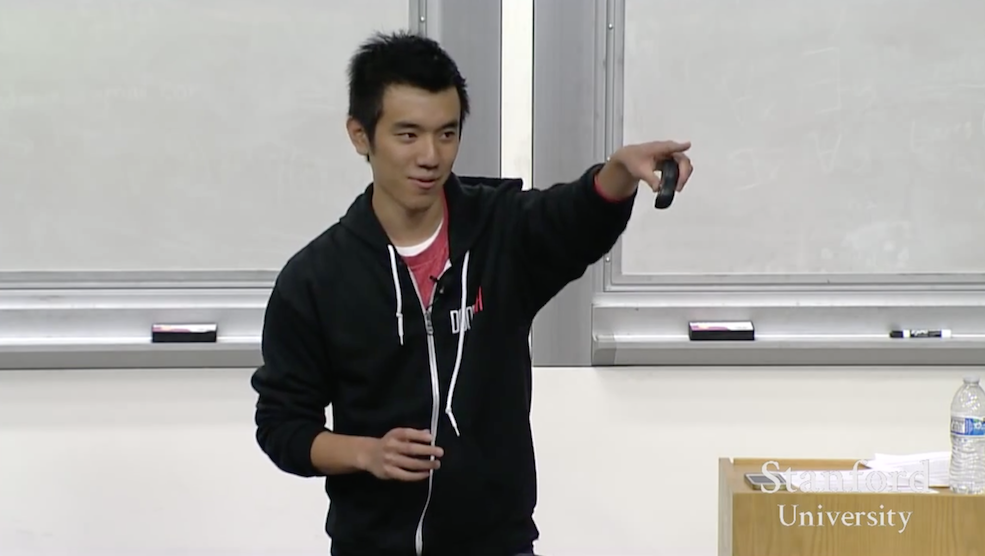
Stanford course CS183B: How to start a startup . Started in 2012 under the leadership of Peter Thiel. In the fall of 2014, a new series of lectures by leading entrepreneurs and experts of Y Combinator took place:
Second part of the course
First part of the course
- Sam Altman and Dustin Moskowitz: How and why to create a startup?
- Sam Altman: How to build a startup team and culture?
- Paul Graham: An Illogical Startup ;
- Adora Chung: Product and honesty curve ;
- Adora Chyung: Rapid startup growth ;
- Peter Thiel: Competition is the lot of the losers ;
- Peter Thiel: How to build a monopoly?
- Alex Schulz: Introduction to growth hacking [ 1 , 2 , 3 ];
- Kevin Hale: Subtleties in working with user experience [ 1 , 2 ];
- Stanley Tang and Walker Williams: Start Small ;
- Justin Kahn: How to work with specialized media?
- Andressen, Conway and Conrad: What an investor needs ;
- Andressen, Conway and Conrad: Seed Investment ;
- Andressen, Conway and Conrad: How to work with an investor ;
- Brian Chesky and Alfred Lin: What is the secret of company culture?
- Ben Silberman and the Collison Brothers: Nontrivial Aspects of Teamwork [ 1 , 2 ];
- Aaron Levy: B2B Product Development ;
- Reed Hoffman: About Leadership and Leaders ;
- Reed Hoffman: On Leaders and Their Qualities ;
- Keith Rabois: Project Management ;
- Keith Rabois: Startup Development ;
- Ben Horowitz: Layoffs, promotions and reassignments ;
- Ben Horowitz: Career Tips, Westing and Options ;
- Emmett Shire: How to conduct interviews with users;
- Emmett Shire: How Twitch talks to users ;
- Hossein Rahman: How hardware products are designed at Jawbone;
- Hossein Rahman: The Design Process at Jawbone.
Stanley Tang: Thanks for inviting me! My name is Stanley and I am the founder of DoorDash . It is wonderful to be here, since not so long ago I also sat in your place. In 2014, I graduated from the Department of Computer Engineering with my co-founder Andy. For those of you who do not know what DoorDash is, I will explain: we are engaged in delivery to small cities in our country.
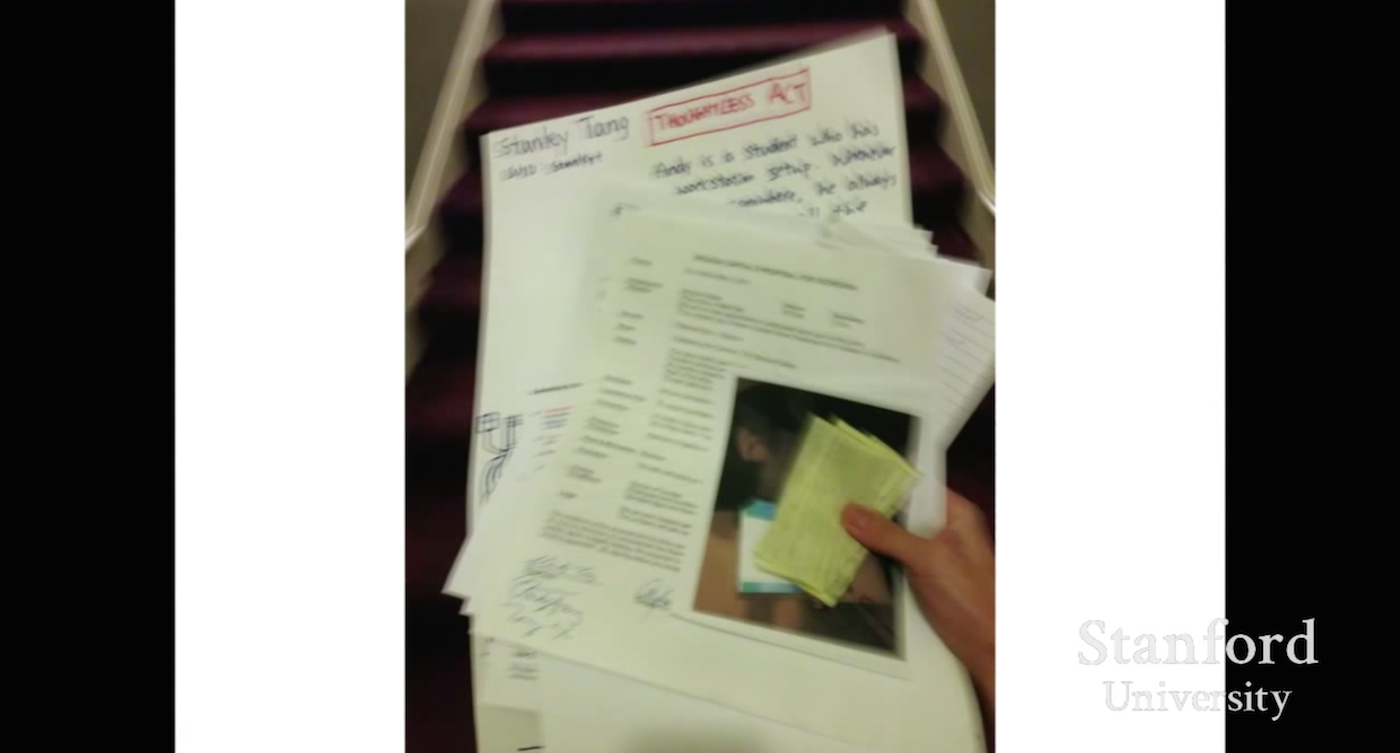
I would like to start my speech with a photograph that I took a few months ago. This photo was taken at night, the day we received the first funding. In the photo I’m already returning to my home, while I was living on campus.
I took this photo because I suddenly realized how ridiculous the set of papers that I hold in my hand looks. Here is my homework done, tax return forms (it was April, and I had to fill them out), a yellow piece of paper is a speeding ticket, and immediately under it lies the $ 15 million contract that I just concluded with Sequoia. This all shows how crazy our journey was, which began at Stanford and ended with the launch of a startup. And today I want to share this story with you.

It all started two years ago in an almond cookie store. This was the third year, fall quarter, at Stanford University. At that time, I was very passionate about creating technologies to help small businesses. I discussed with Chloe, who was the owner of the Chantal Guillon cookie store in Palo Alto, the project we were working on, and also found out what problems she had to deal with during the course of her work.
During that conversation, Chloe first raised the issue of delivery problems. I remember how she showed me an incredibly thick notebook in which, page by page, the delivery orders were painted, and she was forced to refuse to many customers, because she could not physically fulfill them all.
She had no drivers, and it got to the point that she began to deliver orders in person. Perhaps this moment I can call key, we realized in which direction we should move.
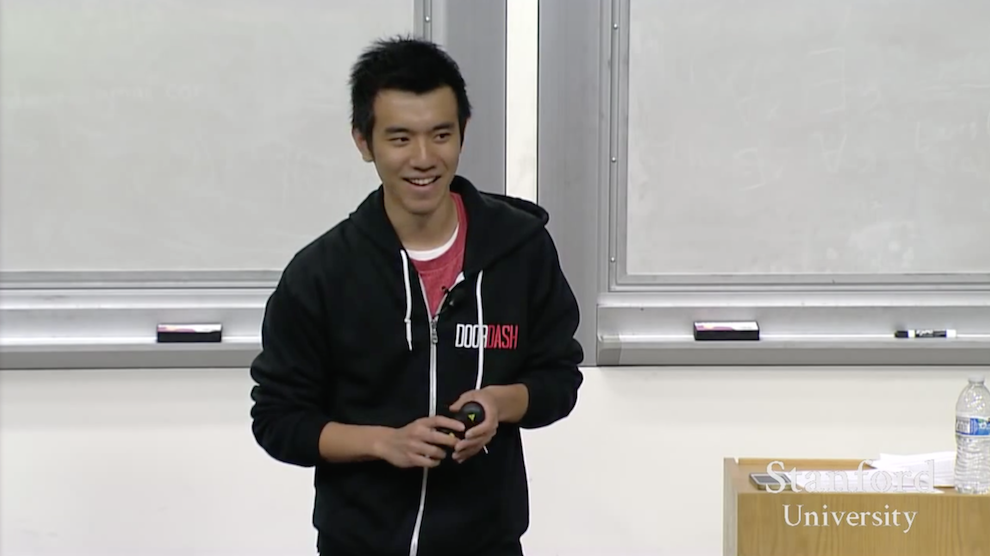
Over the next few weeks, we met and talked with the leaders of about 150-200 small companies, told them about the idea of a delivery service, and they agreed with us and said that it was a good idea: “You know that we don’t have the infrastructure in charge of delivery, and there are no effective solutions to emerging problems, which causes some difficulties. ”
We were very surprised, since the delivery service is a common thing: why has no one thought of this yet? We are definitely missing something, right? We thought that people have already tried to do something similar in the past, but things have failed due to lack of demand.
We asked ourselves: “ How can we verify this assumption? ". And at that time we were just a group of students, we had no trucks, no infrastructure, or anything like that, and we could not just take and build a one-night delivery company. It was necessary to come up with something.
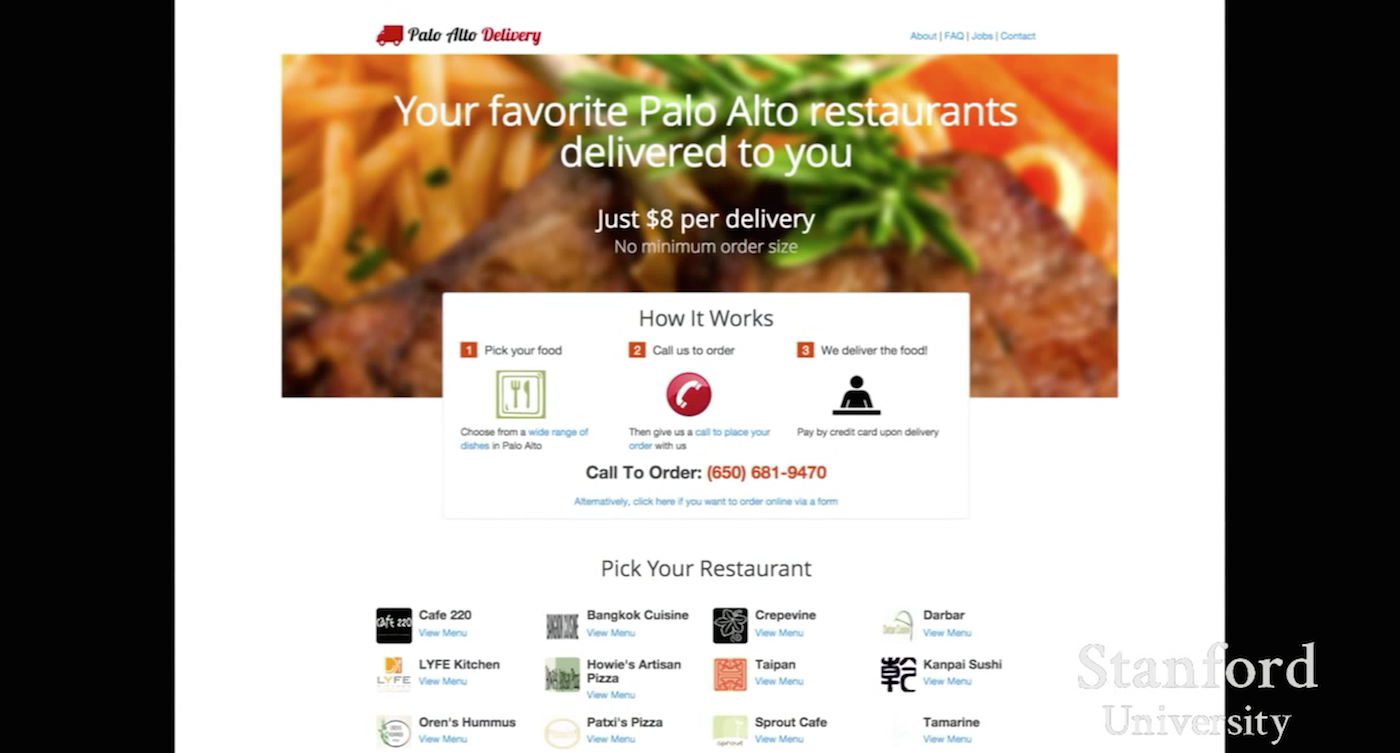
It was decided to conduct a simple experiment with the delivery of restaurant food. We spent part of the day creating a simple selling landing page. On the Internet, I found PDF files with the menus of several restaurants in Palo Alto, and at the end of each of them we entered our personal mobile phone number and fixed them on our page. And that’s it.
We launched the page and named the site PaloAltoDelivery.com. So she looked at that time [slide above]: she was very simple, clumsy, and frankly, we did not expect anything from her - we just started it. We wanted to check whether we would receive phone calls, and if there are enough of them, then perhaps the idea of a delivery service is worth developing.
So, we launched the page, did not expect anything from it, and suddenly, we received a phone call. Someone called us and wanted to order Thai food! We thought: “This is a real order, we need to do something.” We got into the cars and decided, since we are not busy with anything right now, we can drop by to buy Thai noodles, and at least try ourselves as delivery men. So we did.
We delivered the order to a guy, as I remember, living at the end of Alpine Road. We asked him how he found out about us, and what he was doing. He handed me his business card, and it turned out that he was a philologist and author of Weed the People. That was our very first delivery. It was the “best-worst” delivery you can imagine.
And the next day we received 2 more calls. A day later, five, then seven, and then there were 10. And soon we began to gain momentum on campus thanks to PaloAltoDelivery.com. Just think - it was just one page on which you could view the menu and our phone number .
It was not a professional site, but calls and orders kept coming. At this moment, we realized that we had felt for something. If people are ready to put up with the shortcomings of our service, then they really need it.
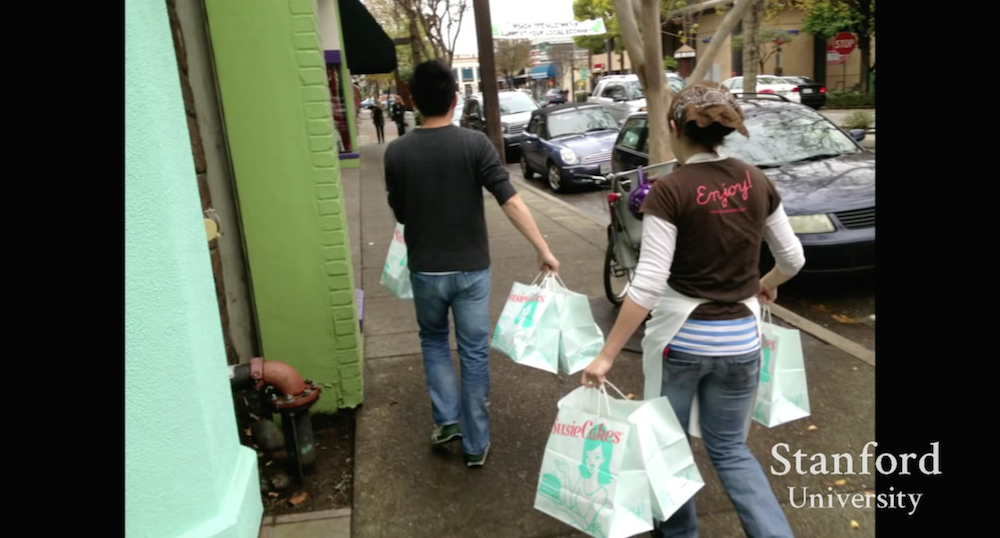
I think another important point is the fact that we launched the project in less than an hour. We didn’t have drivers, we didn’t know how it all worked out, we didn’t have any basic knowledge, and we didn’t spend six months to come up with an abstruse delivery system - we had none of this. We just started the project, because we needed to test the idea in action, launch it, and see if people needed it. Absolutely normal, if at first everything is done in haste.
An expression goes to YC, it is often repeated, and it sounds like this: " Start small ."
At first, we were drivers-forwarding agents — we attended lectures, and after that we delivered food. We were customer support - sometimes we had to answer calls right in the middle of lectures. In the afternoon, we went down University Avenue and handed out flyers so that as many people as possible would learn about DoorDash.
We did not have any dispatch systems, so we had to use Square to collect money from customers. We used Google Doc to track the status of orders, and Apple's Find My Friend to track where our drivers are.
Well, it’s like that, as often happens when you bring together the first solutions that come to mind and try to make them work. In terms of earnings, we grew so fast that Square suspected us of money laundering and closed our account. Imagine how it looked: we received small amounts of money at $ 15- $ 20, and orders arrived at a very fast pace. Fortunately, my co-founder Tony worked for Square, he wrote a couple of emails to his friends, and everything was resolved.
Starting small, you can become an expert in your field:for example, working as a courier allows you to understand the operation of the delivery service as a whole. We took this opportunity and talked with customers and restaurants, we dispatched and sent drivers to addresses ourselves, which helped us understand the work and the sending algorithms of drivers.
We independently dealt with customer support and received first-hand feedback. I remember how, in the first few months, when we just started, at the end of each day, we manually sent an email to each new customer asking us how the first delivery went and how he found out about us. We personified each letter, for example, if someone ordered chicken skewers from Oren's Hummus, we wrote something like: “Oh, and we like Oren's Hummus. Did you like your kebab? And how did you hear about us? ” Customers liked this attention, and we received feedback about our work.
I remember the incident, it happened while studying at YC, we just left the meeting with one of our partner restaurants. We once heard that a place had opened, somewhere on University Avenue called Cream, they were selling ice cream there, and we were going to go try it. Suddenly, unexpectedly, our cofounder from the office sends us a message with the text: “Drivers are urgently needed, we have too many orders,” and we argued for about 10 seconds about whether we should go eat ice cream or go to deliver orders. Of course, we went to deliver orders , the startup motivation for the growth played a role, and we could go for ice cream another time.
Now we work in other cities, and we need to think about process automation, building delivery systems and decide how to satisfy demand - that is, use all these fashionable technological things. But they are absolutely unimportant at the start. When you are just starting out, it’s only important to launch the idea, “take off the ground” and find your niche in the market .

In order to summarize somehow, I note that while doing DoorDash, I learned three things. First, try your ideas in practice, you need to test them in action, that is, conduct a real experiment. The second thing is to start a startup quickly. At the start, it took us less than an hour and only one selling page on the Web.
And the last thing - to start gradually and small - this is in the order of things. In fact, this is one of your greatest advantages, which will help you understand in which direction to develop further when you have a large customer base. And only then, when you succeed, you can go and try that ice cream. Thanks for attention!
How did your very first customer find out about you?
Tang: The very first one? I have no idea. We just started working in Palo Alto and did not carry out any advertising campaigns.
I believe that he simply entered “Palo Alto delivery” into the search bar. After that, of course, we did some kind of marketing. I remember I sent an e-mail to the hostel's mailbox, and then the information about us was spread by word of mouth. This state of affairs reflects how much such a service was necessary if people talked about us and made orders with the terrible user interface of the site, its terrible design and everything else in the same vein.
I believe that he simply entered “Palo Alto delivery” into the search bar. After that, of course, we did some kind of marketing. I remember I sent an e-mail to the hostel's mailbox, and then the information about us was spread by word of mouth. This state of affairs reflects how much such a service was necessary if people talked about us and made orders with the terrible user interface of the site, its terrible design and everything else in the same vein.
Why no one could offer such a successful service to you?
Teng: Looking back, I think that mobile phones played a big role in this. Today, everyone has a mobile phone in their pocket, and seeing this trend, we thought that we could develop a delivery system that would be entirely based on mobile communications.
A system in which there is no infrastructure and delivery vehicles. Instead of hiring full-time drivers or buying cars, why not hook up with independent contractors and just give them orders when they have time. Here's a vision of all this we had then: to do everything with the help of mobile phones.
A system in which there is no infrastructure and delivery vehicles. Instead of hiring full-time drivers or buying cars, why not hook up with independent contractors and just give them orders when they have time. Here's a vision of all this we had then: to do everything with the help of mobile phones.
At that moment, were you working for the very ideas or just wanted to make money?
Teng: At that time, we simply wanted to create technology for a small business, and the delivery project was born from an experiment with a sales page.
It was a pure experiment, we did not expect anything, and seized on the idea when everything itself was untwisted. Yes, and logistics is what we have always been fond of. Transport logistics - the perfect combination - it is both delivery and assistance to small businesses.
It was a pure experiment, we did not expect anything, and seized on the idea when everything itself was untwisted. Yes, and logistics is what we have always been fond of. Transport logistics - the perfect combination - it is both delivery and assistance to small businesses.
The first thing you did was launch a site for mobile devices?
Tang: We started with a classic landing, the creation of which took an hour of our lives.
What distinguishes DoorDash from its competitors?
Teng: At first, the presence of consumer demand was not a problem, as, indeed, now. We just try to find what people need and aim to meet their needs. In the initial stages, competitors do not play a special role.
How long did it take you to become an official company?
Teng: We started the project in January 2013, and finished YC that same summer. We became a company when we decided to go through YC.
Do you plan to deliver anything other than food?
Tang: When we started DoorDash, there was always the task of helping small businesses and figuring out what each entrepreneur could do, no matter if it was the owner of a cookie shop, furniture store, or restaurant.
This has been, is and will be our goal for a long time to come. At the moment, we are engaged in the restaurant industry, with the goal of corporate growth, but in the long run, we would like to continue working in this niche.
This has been, is and will be our goal for a long time to come. At the moment, we are engaged in the restaurant industry, with the goal of corporate growth, but in the long run, we would like to continue working in this niche.

Sam Altman: The next speaker is Walker Williams - he is the founder of Teespring . He worked with YC for about a year and a half. I almost refused him, because his idea looked like complete nonsense, but now they earn hundreds of millions of dollars. It’s great that in the end we work together. Walker is also going to talk with you about how to start with tasks that are inherently not scalable.
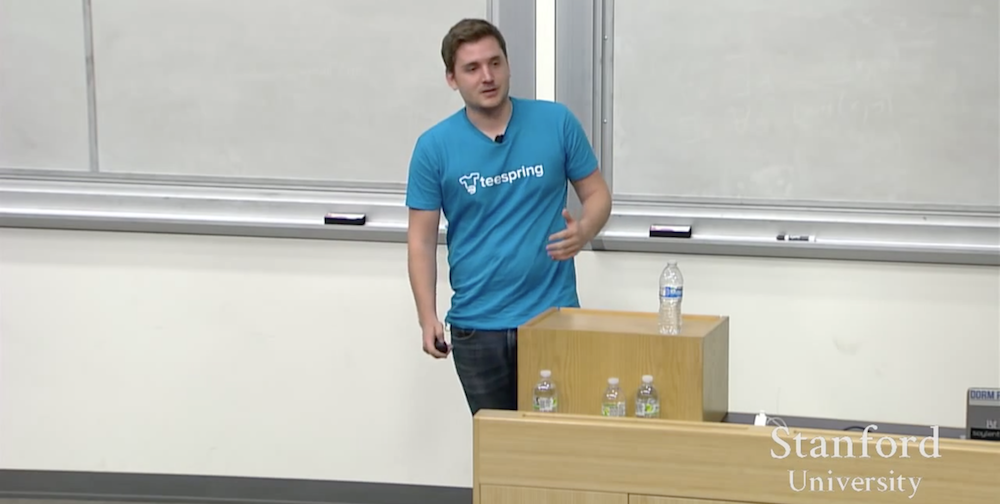
Walker: Thanks guys for inviting me! My name is Walker, and I am the founder and CEO of Teespring. For those who do not know what Teespring is, I’ll tell you: we are an e-commerce platform that allows entrepreneurs to start producing branded clothing without risk and without investment. Today, the company employs 180 people, and every day we deliver to our customers tens of thousands of products. I would like to talk with you about one of the main advantages that you have as a “startup”, starting to work on a small company.

I believe that small companies are fundamentally unstable, do not exist for very long, and they do not have millions of customers. Such companies fall apart over time for many reasons, but they make it possible to understand growth strategies.

Today I would like to draw your attention to three points. The first is the search for your first customers. The second is the transformation of these customers into regular customers. The third is finding your niche in the market.

Regarding the search for the first customers: first, you must understand - there is no universal way to lure a customer. Everyone, including me, starting his own business, was looking for such a magical way: an approach that pays off instantly, or a profitable partnership that will help you get all the way from zero to a million.
But the reality is that the vast majority of companies do not find anything like this, I was convinced of this by talking with their directors. There are no miraculous take-offs, like unicorns. Most of the companies that seem to have found this wonderful method actually got their very first customers with incredible difficulty. Let me tell you a story about a ridiculously unviable business.
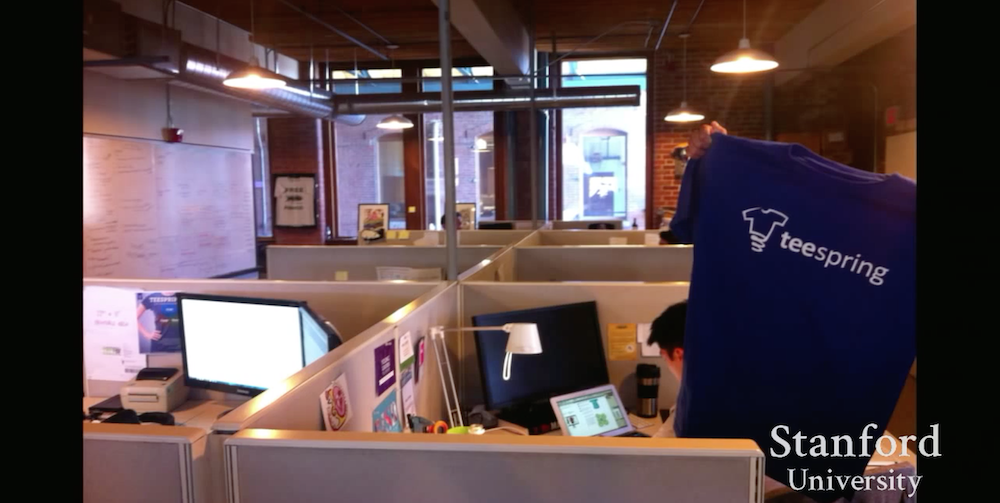
This is what Teespring looked like in 2012 [PowerPoint slide]. When we first started our business, everything went very badly. At the start, it took us days for various meetings, we were forced to offer a free design and spent a lot of time to finalize it. We had to independently produce goods, make advertisements: and all in order to sell 50 shirts of a non-profit organization and get $ 1000 profit.

Anyone looking at this would say, say, give up guys, this is a terrible idea. But time passed, and the first customers began to appear. You must learn: when you first create a company that launches a completely new product, its sales will initially be bad .
Because you have no idea how to influence your customers, because no one has done anything like this before you. No one can tell you how to sell your product, and you cannot read reviews either. Therefore, always the most difficult step is to attract the first customers.

Your responsibility as a founder is to do everything possible to attract them. The ways for each company are different. Most often, the founders should make every effort and spend their personal time, a lot of time, to attract customers to the company.

This means a lot of things: you need to send 100 emails a day, “sit” on the phone, making as many calls as you can, or search for clients through a network such as Stanford or Y Combinator.
You must do everything to get your first customer. I constantly draw an analogy with climbing a boulder uphill. At first you think that this is a smooth hill, but in fact it turns out that it is a steep mountain, and rolling a stone a few inches is not so easy. But as you move forward, the slope becomes less steep, it becomes easier to roll a stone, and suddenly you find that you are already at the top, and the boulder starts to slide down the mountain itself.

When working with those first customers, you should not focus only on making a profit. Do not expect to earn thousands of dollars in one hour. Although the incredible story of Stanley makes you think about the existence of unicorns, for most of us, the first customers will require great dedication and great love - this is necessary to create a company.
I just want to warn you: do not give away your product for free. There are many exceptions to this rule, but in any case, to reduce the cost of goods or give them away for free is a very unreliable strategy that I would not recommend applying. You must make sure that buyers appreciate your item. And you know that people treat differently free and paid goods, and sometimes this can inspire you with a false sense of calm: “Oh, we have so many customers, now we can definitely start selling.”

What to do after you get your first consumers? How to turn them into regular customers, such customers who would tell and recommend your product to everyone? A company with successful growth is clearly engaged in attracting such people. The easiest way to make them recommend your product - to do something pleasant, something unusual and extraordinary - leave them a good impression.

The easiest way to do this as early as possible (this method is unreliable and does not scale well) is to simply talk to clients. They will always tell you about this - this is a kind of basic rule of Y Combinator: talk with your customers .
I can not stress how important it is to spend a lot of your time on such conversations. You must do this constantly, every day and for as long as possible.
Today at Teespring, I’m still tracking our email, so I’ll notice if someone makes a mistake in the word “support” or writes a non-existent address. I still serve about 10-20 customers a day and spend several hours every night reading every tweet - maybe I'm overdoing it, but there's nothing wrong with that.
I went through every Teespring community, because by listening to customers who have experience working with you, you’ll get the most complete picture of your product, especially in the early days. A product released in its original form is most likely not quite what consumers expected from it, and the sooner you find out, the sooner you will begin to develop.

There are three points to consider when communicating with customers.
The first is to work as an employee of customer support. Until Teespring began to earn $ 130- $ 140 thousand per month, I and my co-founder Evan took over the duties of the customer service.
At such a moment, there will be a desire to quickly pass this stage - it is morally difficult. Even today, when I open our customer service portal, emotions start to overwhelm me and my stomach just turns upside down, because it’s very bad to talk to so many people who speak badly about your product. It is very painful to realize that what you loved and what you put so much effort into was done wrong or was misunderstood by someone. But it is very important to go through this stage and understand what needs to be added and what needs to be fixed.
The second point - you need to keep in touch not only with customers whose orders you are working on, but also with those whose order has been completed, but they refused to deal with you in the future. This category of customers is constantly forgotten in the pursuit of new customers. But you need to make sure that your customers have a good impression of working with you, otherwise they will simply go to competitors.
When the client leaves, you need to contact him and find out why he did this, since your personal intervention may affect his decision. Sometimes people just need to know that you care, and everything will start to change for the better. And even if the client does not want to go back, you will take into account the mistakes that made him leave, and correct them in order to avoid the recurrence of such a situation in the future.
And finally, the last thing that interests me the most is social networks and communities. You need to know what people are saying about your brand. You should try to find out if someone left a bad impression, and what people say about it to correct the flaws.

Problems are inevitable. You cannot create the perfect product, sometimes something breaks, sometimes something does not go according to plan. It does not matter. It’s important to always move forward, and sometimes it’s worth going the extra mile just to make one client happy.
The one and only slanderer who left a bad impression of your work is able to discourage ten regular customers from working with you. He just needs to say something like: “You should not work with these guys for such reasons,” and that’s all, this can turn back all progress.
I can give an example when in the early days we got confused in a large number of orders. We mixed up the colors a bit, incorrectly chose the size of the shirt, and the order cost was half of our earnings for the month. We knew that we were mistaken, and that the client would be unhappy, and there was a huge temptation to lie to him and say that everything was in order. But the reality is that you grit your teeth and tell the truth. Although in such situations, customers are very disappointed, as a rule, they remain working with you and become the most loyal regular customers.

The last thing I would like to talk about is finding your market share. By this, I mean that the product that you launch on the market with 100% probability will not lead to the growth of the company [in its original form], so in the first days it becomes your task to bring it to mind so that it becomes competitive as soon as possible.

For this, as true engineers, you will want to create an excellent platform, write code without bugs and make the project scalable. There is no need to write the code “with crutches”, because soon because of this you will accumulate a huge amount of “technical debt”. But at the same time, over the purity and scalability of the code the speed of its execution prevails.
As an example, I can give one of the last cases. We got a couple of corporate clients, one of the large non-profit organizations, who said: "We really like your service, but you do not have these very important functions, so we will not use it." We examined the ideas they proposed and considered what their implementation would cost us, we were not sure that such functions would be used by anyone else, but we really wanted to try to translate the ideas into reality.
My co-founder Evan, our CEO and a million times better developer than me, did a few calculations and came to the conclusion that if everything is done correctly, it will take about a month to launch the functional.
A month for a startup is like a whole year in which anything can happen. Therefore, he made copies of the code, the database and began to implement a completely different project for corporate clients, which absolutely did not affect customers who already use our service. After creating the second service, new companies got involved, and we got a lot of income. After that, we found out which options are the most important, and added them to the main service, but we did it already not in a month, but in three to four days.

The most important rule is that you only need to worry about the next step. Having gained the tenth user, you do not need to think about how to serve ten million. When you get to this, then you will think. When you have 100 users, you need to think about 1000. When you reach such a tipping point, your needs will make you creative (Twitter Fail Whale is a very good example).
We at Teespring had some very difficult months when our site “crashed” every night. Every night. All team members went to bed with the phone under their pillows, so that at any moment when the bell rang, you could quickly restart the server and sleep on. This went on for days.

But in fact, all these difficulties, all these lines of crooked code and frustration help to quickly achieve the goal - to create a competitive product. If the project works, you will survive in the market. All these difficulties are like bumps on the road that do not allow you to accelerate.

The lesson I subsequently learned was that you need to do small projects for as long as possible. There are no secrets in this, it is not the first financing and the undefined amount of income that determines the moment when you need to start expanding the company.
The ability to engage in such projects is one of your greatest advantages, and by abandoning it, you give other companies a head start. As long as you have the strength and opportunity, communicate with customers, do not give up on this voluntarily - when the company begins to grow, the opportunity will disappear by itself.
Why textile printing, because there are so many competitors in this area?
Williams: I have to agree - this is a good question. People constantly told us, at all stages of our development, that this is a stupid idea.
The phrase “this is a terrible idea, why are you doing this?” Sounded constantly. But the reason for starting our project was a personal need. We somehow needed a service of this type, but at that time we could not find anything like it.
When I was a student in Brown, I somehow tried to create a t-shirt with the inscription “Remember the Bar” for the eatery, which now closed, and could not find anything that would suit my requirements. I found a problem and saw that the market was filled with similar companies, but I also saw that people were buying goods anyway, and I knew that there was room for maneuver.
There was a feeling, well, you know, when you move, as if in the wind, in the direction where the goods will be sold. I saw the problem, and I knew that the need for such services would not disappear in the near future. I have to say that in most cases, good ideas at first look like stupid ones, and already over time you can feel whether the business will come out of it and if you can attract customers.
The phrase “this is a terrible idea, why are you doing this?” Sounded constantly. But the reason for starting our project was a personal need. We somehow needed a service of this type, but at that time we could not find anything like it.
When I was a student in Brown, I somehow tried to create a t-shirt with the inscription “Remember the Bar” for the eatery, which now closed, and could not find anything that would suit my requirements. I found a problem and saw that the market was filled with similar companies, but I also saw that people were buying goods anyway, and I knew that there was room for maneuver.
There was a feeling, well, you know, when you move, as if in the wind, in the direction where the goods will be sold. I saw the problem, and I knew that the need for such services would not disappear in the near future. I have to say that in most cases, good ideas at first look like stupid ones, and already over time you can feel whether the business will come out of it and if you can attract customers.
Are nonprofits your largest customer base?
Williams: No, today most of our customers are entrepreneurs who are trying to create brands and start their own business. A little more than 1000 people began to earn a living by launching brands with our help. We also work with YouTube stars, Reddit communities and bloggers who want to sell clothing with their own branding.
[ Translation of Justin Kahn's next lecture ]
